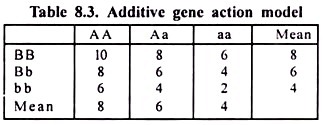This article throws light upon the following three main types of gene action. The types are: 1. Additive Gene Action 2. Dominance Gene Action 3. Epistasis.
Type # 1. Additive Gene Action:
When the genes act in such a way that substitution of one allele for another produces same plus or minus effect regardless of other gene (s) and the effect is the same whether replacement occurs in a homozygote or heterozygote, the gene action is said to be additive. This is illustrated in Table 8.3.
This illustration shows that Aa = AA + aa/2 = 8, implying absence of dominance. This is true at Bb and bb levels also. Replacement of a by A produces a plus effect of 2 units disregarding presence of B gene and genetic phase at B locus showing no interaction between A and B. Further, totals of any 2 diagonal values are equal showing no interaction.
Type # 2. Dominance Gene Action:
When the genes act in such a way that the substitution of A for a in the genotype aa is not the same as in the genotype Aa. A dominance gene action model assuming complete dominance at both A and B loci and without interaction is shown in Table 8.4.
This model shows that Aa = AA disregarding whether at other locus there is BB or Bb or bb. Likewise Bb = BB. Thus, there is complete dominance for both the genes and interaction is absent. No interaction between A and B genes is further reflected by the fact that total of any 2 diagonal values is the same.
Type # 3. Epistasis (Inter-Allelic Interaction):
This is a type of gene action in which the genotypic values associated with genetic phase at one locus are influenced by genetic phase at the other locus. Epistasis cannot occur of its own. It always occurs along with either additive or dominance gene action or both. This interaction could be additive x additive, additive x dominance or dominance x dominance type. An additive x additive type interaction is shown in Table 8.5.
In this given model, Aa = mean of AA and aa and similarly, Bb = (Bb + bb)/2 showing no dominance. Further, substituting a by A has equal effect from aa to Aa and from Aa to AA (3 units with BB, 2 units with Bb and 1 unit with bb). Same is true for B gene. This shows additive gene action.
However, the amount of shift at A locus is not independent of genetic phase at B locus and vice-versa implying interaction, which is also reflected by the fact, that the diagonal totals are not matched. This model shows epistasis of additive x additive (A x A) type. Likewise, epistasis could be additive x dominance (A x D) or dominance x dominance (D x D) type.
The overall consideration leads to:
P = G + E
= A + D + I + E = A + D + AA + AD + DD + E
Interaction is of 2 types:
(i) Complementary Type:
This involves interaction between 2 non-alleles complementing each other to produce a new phenotype which is not ascribable to them individually. This is created by the interaction of 2 homozygotes, each acting additively (additive x additive i.e. A x A). Complementary (9: 7), recessive epistasis (9: 3: 4) and polymerism (9: 6: 1) are examples of this type.
(ii) Duplicate Type:
This involves 2 non-allelic genes which tend to cancel or weaken the effect of each other in hybrid combination. Such a variation arises from homozygote-heterozygote (additive x dominance) or heterozygote-heterozygote (dominance x dominance) combination. Inhibitory genes (13: 3), duplicate genes (15: 1) and dominant epistasis (12: 3: 1) fall in this category of interaction.
When dominance (D) and D x D components have same sign (+ or -), epistasis is complementary type, otherwise duplicate type.


